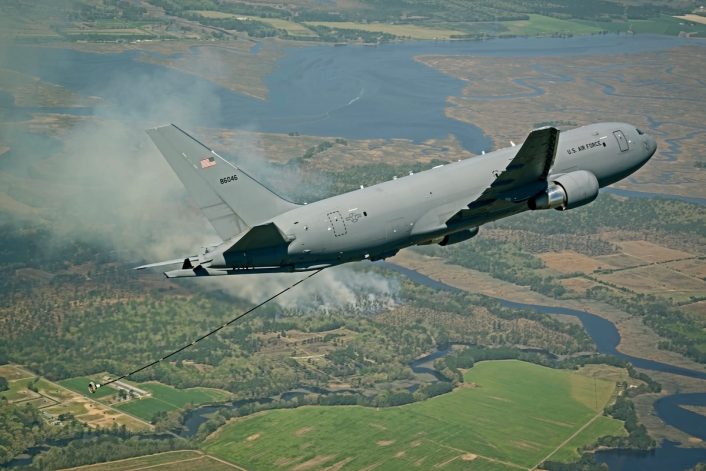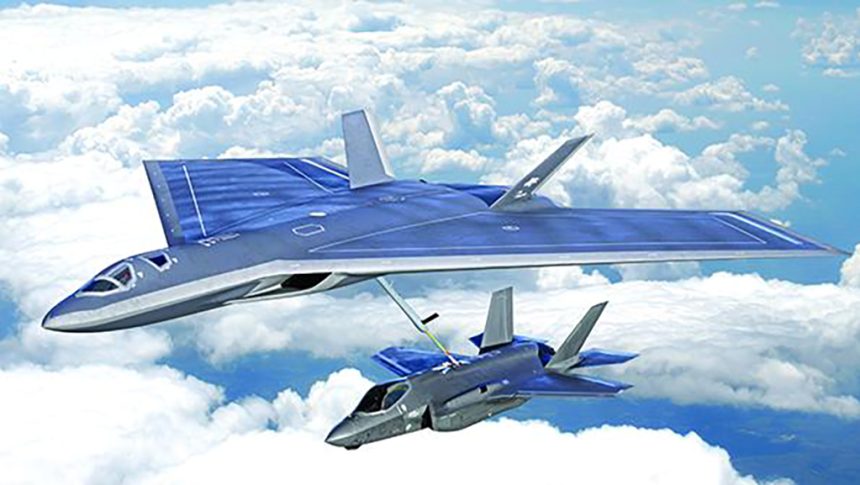Lockheed Martin’s secretive division released the rendering of a notional stealth tanker for the Next-Generation Air Refueling System program which aims to replace KC-46 and KC-135 tankers.
Lockheed Martin’s highly secretive Skunk Works division released a rendering of a notional stealth tanker meant for the Next-Generation Air Refueling System program, also known as KC-Z, which aims to replace KC-46 and KC-135 tankers in the 2030s. The tanker, which appears smaller than the types it will replace, is shown refueling an F-35A with the flying boom system.
The aircraft in the rendering, first published by the Aviation Week, appears to be based on a rather large lambda wing with canted twin tails. The engines, possibly two, are buried in the fuselage, with the air inlets under the wing’s root (also called “armpit” inlets) and possibly flat nozzles in the rear.
While the design in the rendering is notional (Lockheed Martin released another completely different rendering last year), it is interesting to notice that the concept of low observability is also making its way into the high value air assets. However, similarly too what we mentioned many times for the Next Generation Air Dominance program, the renderings might not be representative of the real designs being developed.
Last year, the U.S. Air Force released a request for information to the industry for a new tanker capable of surviving in contested airspace, mention the service is interested in innovative solutions in all size and performance classes that might address the stressing mission requirements. The service has later started an analysis of alternatives.
The Next-Generation Air Refueling System
NGAS will be the third of three increments to the Air Force tanker recapitalization plan, following increment 1 (represented by the KC-46 program) and increment 2 (known as KC-Y or “bridge tanker”). The new tanker would be able to operate closer to the frontlines to better support fighters, while more “traditional” tankers would be employed at a safer distance.
“It’s not one airplane. It’s a system, so it’s not one-size-fits-all. I’m not looking to develop a fleet that has to handle every threat environment,” Gen. Mike Minihan, commander of Air Mobility Command, told reporters earlier this year.
Gen. Minihan previously said he envisions three roles for tankers as part of NGAS. The bulk of the air refueling missions would be performed in a permissive environment by “traditional”, commercial-based tankers such as the KC-46, while a second tanker would operate closer to the fight thanks to improved survivability and connectivity.

The last type, possibly KC-Z, would operate in the same area of operations of fighter jets for high-end missions, so it needs to be small and survivable. Because of this, it needs to have more self-protection and advanced networking than the current types, addressing threats that are posed by potential adversaries to high-value aircraft such as tankers while still being able to perform its air refueling mission.
In addition to refueling, these aircraft might do much more, said Gen. Minihan. In fact, he listed open architecture, autonomy, and battle management capabilities among the things that could be included on the new aircraft. Some of these capabilities might find their way on operational KC-46s even before NGAS enters service.
The plan for the new tankers, however, is not final. Last year, the Air Force said it will buy only 75 tankers as part of the upcoming “Bridge Tanker” and push to field NGAS faster. For sure, funding will get a big role in the plans as the Air Force is already working on big programs such as the B-21 Raider and NGAD and the new tankers need to be fielded “without bankrupting the Air Force,” said Gen. Minihan.









